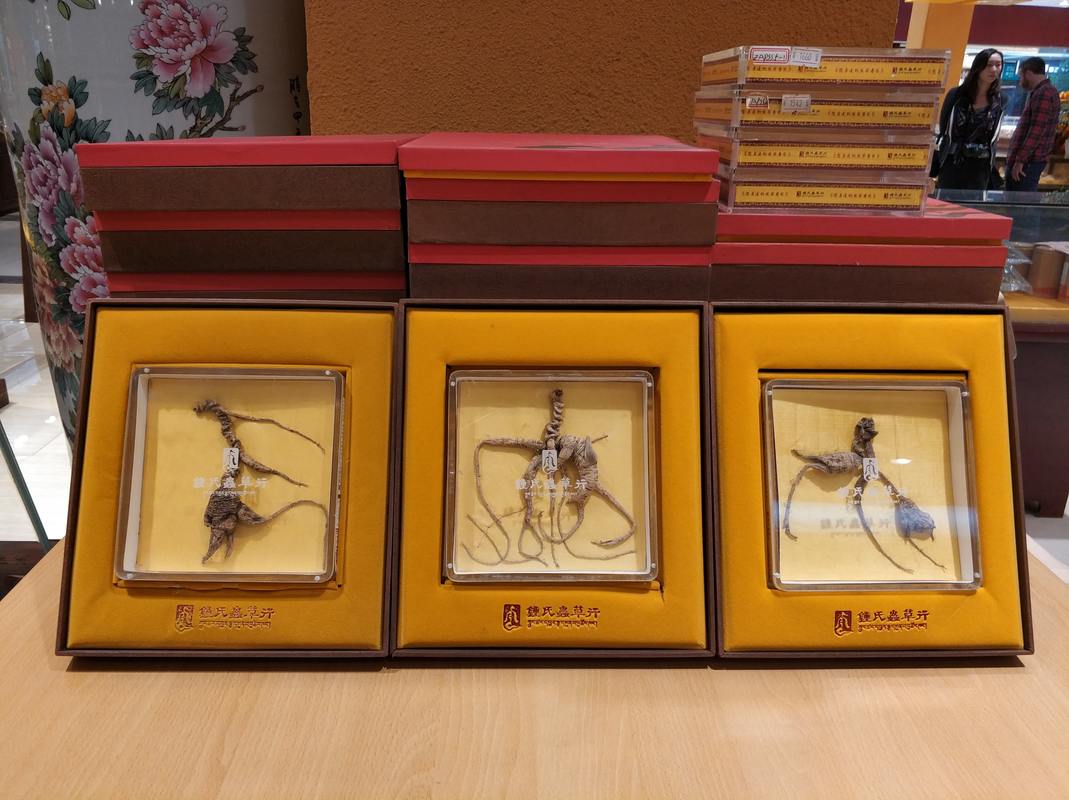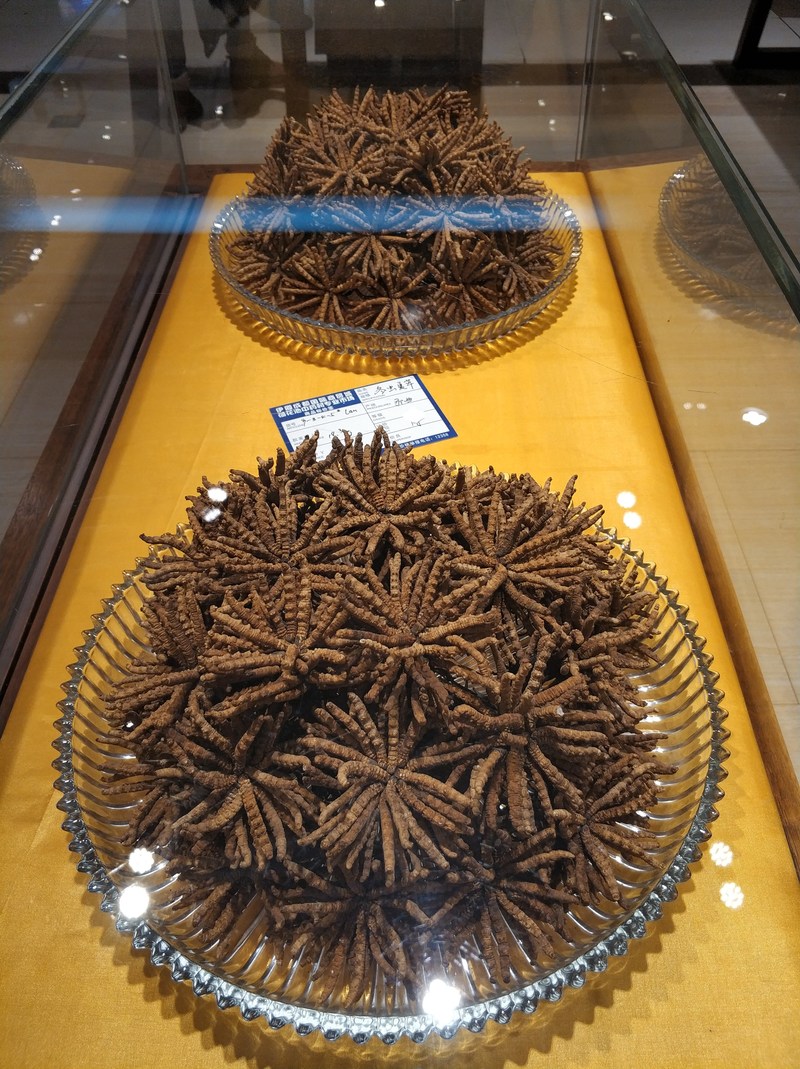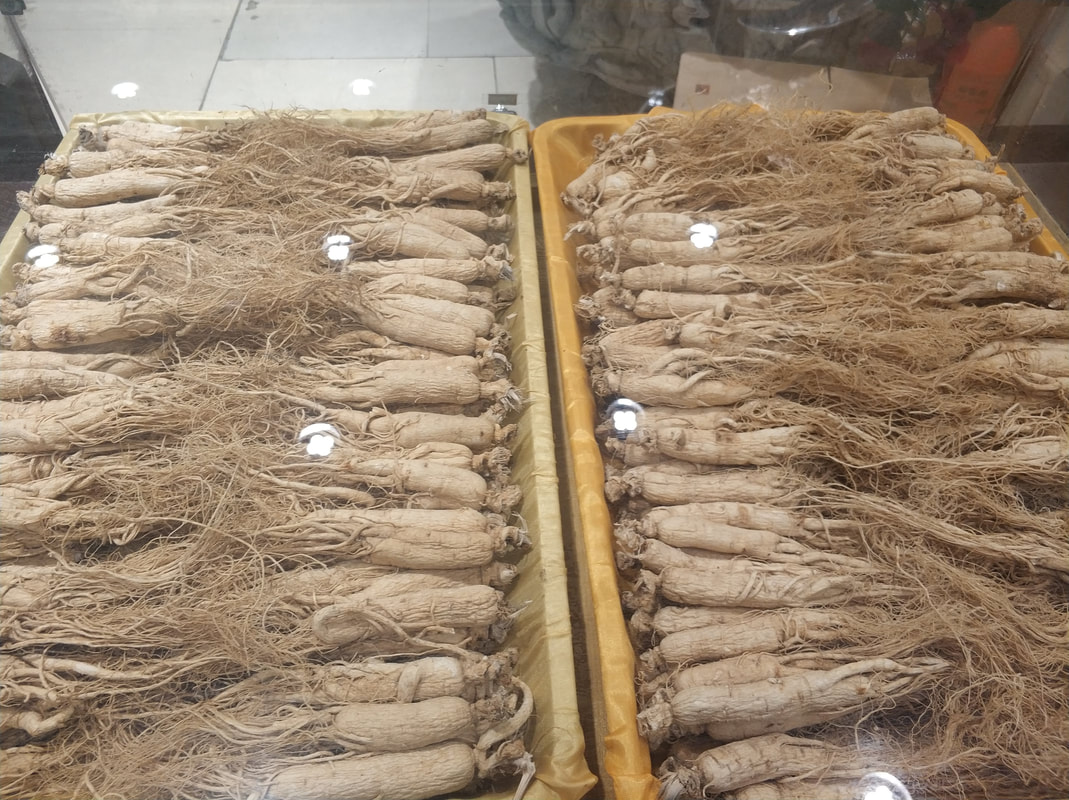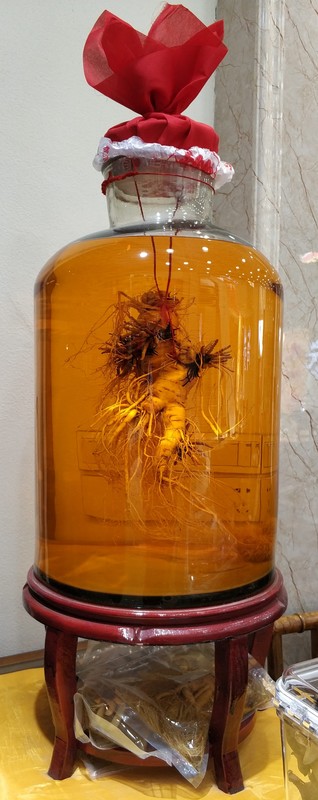|
When ginseng grows into unique, remarkable shapes or has the figure of a human, the root is displayed in a fine case rather than used as treatment. These pieces can be worth quite a large sum of money. Sunday we spent half a day at the Herbal Medicine Market in north Chengdu. It is a wholesale market for purveyors of TCM (Traditional Chinese Medicine) practitioners such as doctors and acupuncturists. Although well known in that community, it is NOT a tourist destination, so the owners, customers, and other people in the 1800 or shops within the complex are not used to seeing us long guilao "foreign devils" or "white ghosts" (old Cantonese/Mandarin slang for foreigners), so we received stares upon stares--especially this blonde ghost! It felt like being back in Kham (Western Sichuan) during my travels, where long guilao--moste especially blonde or red hair - -may have never been seen before by locals! Famous again! One of the reasons I moved to China was to experience and learn firsthand the traditions of herbal medicine, Qi Gung, and Taoism... and I found one source! My friend, M., had recently discovered an English-speaking TCM who originally hailed from Australia, but lives and practices in Chengdu. Dr. Adam Tate was our host, and presented the tourat the market, to be finished with an herb-full healthful, medicinal meal back at Panda Guesthouse, where we all congregated to begin the tour. The tour was also hosted by Liz from Fat Cat, a local start-up art space and gallery, recently opened by her and her Chinese fiance'. They hired Didis (Chinese Uber) for our group of 12, and we set off for the very, very long drive up north to the market. Read on for photos and to learn about these herbs -- some of which originated in the west and migrated to China; although unfortunately, we no longer use these vital, healing herbs. The majority of the herbs are locally harvested and grown, here in Sichuan, or in the nearby provinces of Yunnan and Tibet! Others, such as saffron, are imported from India, Iran, Africa, and Europe. Ophiocordyceps, known as Yartsa Gunbu in Tibetan: "summer grass, winter worm". The most prolific item for sale in the market at this time of year is cordyceps, aka caterpillar fungus. In fact, Dr. Adam claimed that there are millions and millions of US dollars worth of Cordyceps contained in the collective shops of the market! This herb (actually a fungus) is a major part of the economy of the Tibetan populace who live near the high mountains where it is harvested in the Autonomous Regions of Kham (Western SIchuan), Tibet, Yunnan, and Qinghai. (These are the provinces of which I learned, there may be more.) Cordyceps is remarkable in that it is a fungus which invades a small caterpillar, and grows outward in a black string-like projection as it mummifies its host. It is a tonifier, which strenghtens the whole body. Pharmacology: libproject.hkbu.edu.hk/was40/detail?lang=en&channelid=1288&searchword=herb_id=D00019 Ginseng is also a tonifying remedy, called renshen in Chinese. Asian ginseng -- panax ginseng -- is a creamy-white when pulled fresh from the earth and used to increase yin energies. Red ginseng, like Korean ginseng has been preserved in alchohol and increases yang characteristics. About yin and yang: www.tcmworld.org/what-is-tcm/yin-yang-theory/. Both cordyceps and ginseng are among the many "graded" medicines in the market; graded for quality, such as AAAAA vs. AA. Glass cases full of ginseng line the aisles in one of the more highly regarded reputable shops, where the herbs are packaged attractively and of higher grades. Click read more to the right, for many more photos and info about TCM and the medicine market! Ginseng and cordyceps tincture in ju (Chinese liquor similar to vodka, but rice based. A tincture is made by soaking an herb in alcohol for a long period. I took pages of notes during the tour --Geek that I am, you know me!-- and eclipsed others in the group with my multitudinous questions! Let me infuse you with all that I learned! The herbs and descriptions are not in any particular order, Dr. Adam lectured as we walked through the market. Panax Ginseng treats "wind diseases": high blood pressure, illness stemming from nervous system dysregulation. Seahorse is an androgenic. Orange peel (CH: Chen Pi) is used in infusions (a strong form of tea made by steeping for 8-24 hours). The piles of orange peel we came across were taken from Chinese Mandarin oranges, and are dried for years to enhance their medicinal properties. Chen Pi clears damp and is good for stomach problems. Son Qi looks like miniature ginger root and is used for bruising, blood regulation, circulation, and heart disease. Deer horn - which is bone - is used for bones. Many Chinese medicines match the physical with the healing quality, thus horn for bone and joint problems, slipped discs. It is "yang" and regenerative. The younger age of horn has stronger potency. Many deer farms exist to provide the horn, which regrows after removal. In other words, the deer does not have to be killed to obtain the horn, which is good! False saffron (CH: hong hua) is deep red and thus good for blood problems, cramps, stagnation. Used in a footbath or as a tea. Amber is grounding because it has been underground for thousands of years. The same goes for fossilized bone and shells, applicable for bone problems; also oyster shells have the same application. There are actually real (not alive anymore) fossils at this market!! Frankincense (affects Qi) and myrrh (affects blood) , (not just for Jesus anymore!) are used together to move the blood (improve circulation). Chuwon Xien is a blood mover used for headache, PMS, and I have no recollection which herb this is as I write this one month later! Walnut - which looks like a miniature brain, is used - not surprisingly - to aid the brain, along with the liver, due to the presence beneficial fatty acids. Walnut is a perfect example of the "signature" of an herb: "sign" + "nature" = signature; how it looks is what it is used for. Another example is saffron and false saffron, which are crimson red in color, and it follows, used as blood tonic. Wolfberry (black goji) and red goji berries are blood tonics. Earth worm has "five effects"; (think of earthworm segmentation);,opening up and clearing blockages; consider how they burrow through the earth, opening passages and clearing blockages. Scorpion and centipede clear toxins and cure tumors, neuralgia (nerve pain), and neurotoxins. www.ncbi.nlm.nih.gov/pmc/articles/PMC4663536/ www.chineseherbshealing.com/scorpion-facts/ Hawthorne berry remedies heart issues. Lizard - used for their androgenic properties. Snake - think of how they shed their skin; used for skin conditions such as psoriasis and eczema. Turmeric - (CH: Jian Kwan), anti-inflammatory and blood tonic, well known in Ayurvedic Medicine. I was thrilled to learn I could find it fresh at the market! Lizard and walnut combo - used to treat asthma. One particular healthy soup includes white fungus and goji berries. Chrysanthemum flowers and buds - buds are less bitter than the flowers, clears heat and toxins, frequently used as a tea with goji berries, flowers have similar calming property of chamomile, good for skin. Rose petals - also frequently drunk as a tea, reduce PMS and heart problems Saffron (CH: Qi Hong Hua. Qi = life energy, Hong = red) - the color of iron; saffron is a blood mover and increases blood circulation, helps PMS, heart problems, and helps the spirit during depression. It used for Clinical Depression (Major Depression) as it cheers the spirit. Rhodiola and Himalayan Snow Lotus flower are used to prevent/cure altitude sickness. Mixture of walnut, figs, and raisins are good for the lungs, helping bronchitis, coughs, and the like. Miscellaneous Facts: - "Damp" causes chronic disease like rheumatoid arthritis, cancer, and more. - Herbs and flowering herbs have potent and high amounts of antioxidants and Chinese drink herbal tea on a daily basis, even in summer. - "The Spice Trail" Documentary enlightens with the history of spices coming into China along "The Spice Trail". I've learned there are many "trails" and "roads" through China: The Tea Horse Road, The Spice Trail... - Millions of dollars worth of cordyceps reside in the market; cordyceps comprises a large percentage of yearly income of many Tibetans and other ethnic groups in the growing areas of the high mountains and Tibetan Plateau. - Saffron is extremely pricey as well: 1 g. = $4 USD Photos from the tour range from praying mantis egg cases, to deer penis, and white fungus to peach tree gum... along with AAAAA-grade specimens of Maria and Gina, and Dr. Adam. Photos, in order, but not-inclusive: birdnest, cordyceps, seahorse, ginseng, tincture (rice liquor, seahorse, ginseng, cordyceps, deer antler, deer penis, and deer tendon), locust cordyceps, scorpion, amber and frankincense and myrrh, "false" saffron aka hong hua, fossils (yes! some are dinosaur bones!),earthworm, lizard and snakeskin, snake, preying mantis eggsack, white fungus, tuber (?), rhodiola, Himalayan snow lotus, peach gum (tree sap)... *Please note: I did my best with the translation and pinyin (the modern method of writing Mandarin using the Roman alphabet); any errors are my own or Google Translate's. Any error in herb nomenclature or usage is mine own, and comes from hurriedly taking notes whilst walking and listening and looking at all the intriguing wonders of the medicine market! To learn more about Tibetan culture, cordyceps, and Traditional Chinese herbal medicine:
www.medicinetraditions.com/the-four-elements.html (Dr. Adam's site is encyclopaedic, like his mind!) www.nationalgeographic.com/magazine/2012/08/tibetan-mushroom/ http://mushroaming.com/Yartsa_Gunbu_Cordyceps
0 Comments
Leave a Reply. |
iGallivant......has studied Daoism, TCM, QiGong, and Taiji the past few years... good thing, since I moved to China!! Archives
October 2018
Categories |




 RSS Feed
RSS Feed
